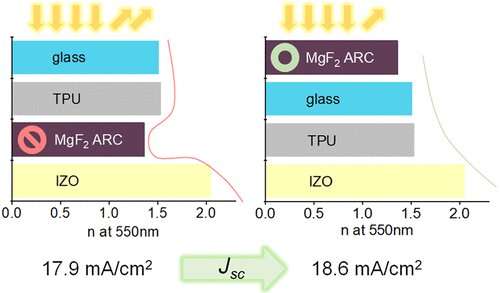Reordering the layers in solar-cell modules can help improve efficiency

A solar-cell module that mitigates cell-to-module losses has been developed by KAUST researchers following a rethink of the module's optical design and how it should be stacked.
Research laboratories around the world are working to constantly improve the efficiency of solar cells. But using these devices in the real world represents an extra challenge. For example, solar cells need to be incorporated into modules that can protect the sensitive materials from harsh environments. These modules can reduce the power conversion efficiency, thus losing the performance gains so diligently won in the laboratory.
Lujia Xu, Stefaan De Wolf and their KAUST colleagues have constructed a more efficient solar-cell module with an enhanced optical design. The solar cells used by the team were made of a combination of two light-absorbing semiconductors: one silicon and the other made from a perovskite material. Silicon is now a well-established material in solar cell manufacture. And while perovskites are an emerging material, adding a thin layer on top of the silicon has already been shown to improve performance with an acceptable increase in cost.
These so-called perovskite–silicon tandem solar cells have previously exhibited efficiencies in optical-to-electrical power conversion as high as 30%. And theoretical modeling has indicated it could go as high as 45%. But when the KAUST team put their tandem solar cells into a module, they found that the efficiency dropped from 28.9% to 25.7%. Their module was made by sandwiching the solar cells between two glass sheets, with the inside filled with thermoplastic polyurethane to encapsulate the solar cells.
The team believe the reduction in efficiency is due to a refractive index mismatch after the introduction of glass and the polyurethane directly on solar cells without cell-to-module optimization, resulting in increased reflection of the incoming light. And so the team decided to reduce this front reflection loss by an optical redesign of the module through refractive-index engineering.
By moving a film of magnesium fluoride from the top of the cell to the top of the front glass, they reduced the refractive index mismatch, thus achieving efficient light in-coupling.
"This simple optimization effectively enables the highest short circuit current density—related to the maximum current that can be drawn from the device—that is reported in the literature for monolithic perovskite/silicon tandem solar modules, resulting in a power conversion efficiency increase from 25.7% to 26.2%," says Xu. "We now hope to explore how different materials and texturing the material surface could reduce the current losses from cells to modules even further."
The study is published in ACS Energy Letters.
More information: Lujia Xu et al, Monolithic Perovskite/Silicon Tandem Photovoltaics with Minimized Cell-to-Module Losses by Refractive-Index Engineering, ACS Energy Letters (2022). DOI: 10.1021/acsenergylett.2c01142


















